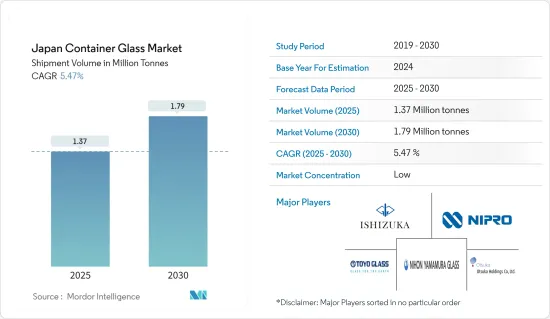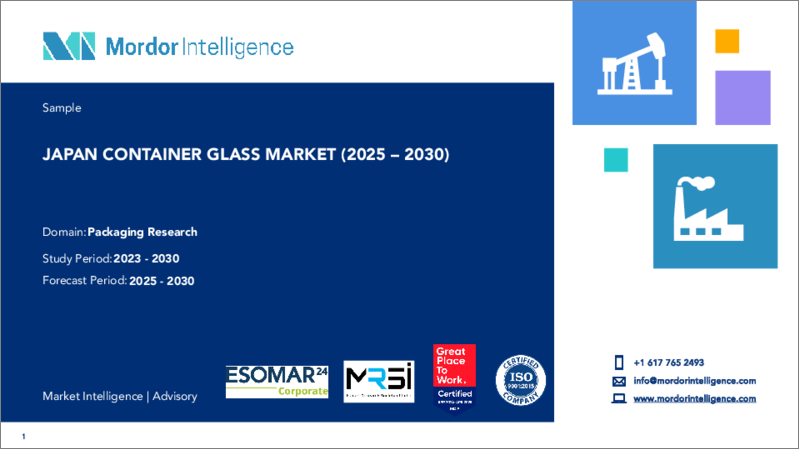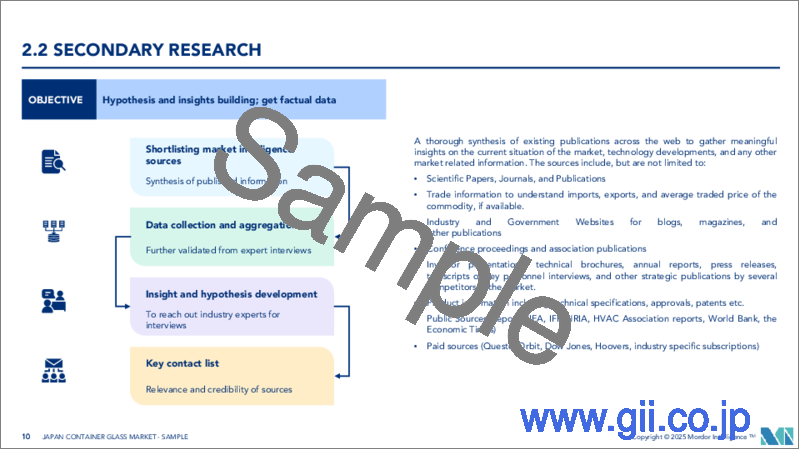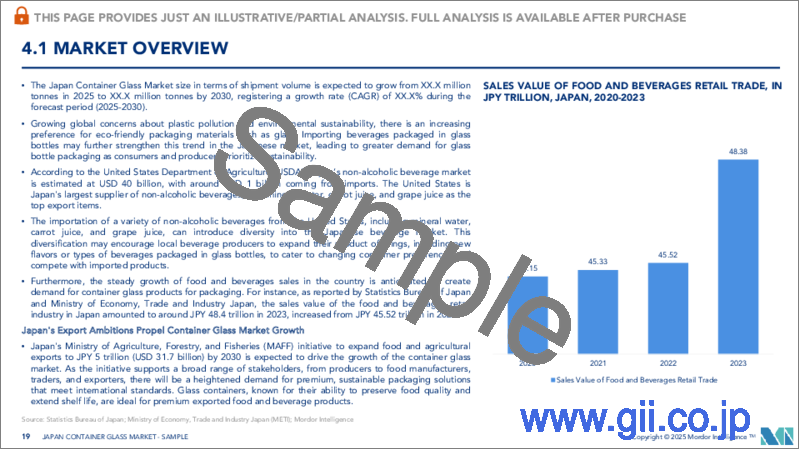|
|
市場調査レポート
商品コード
1635455
日本の容器用ガラス:市場シェア分析、産業動向、成長予測(2025~2030年)Japan Container Glass - Market Share Analysis, Industry Trends & Statistics, Growth Forecasts (2025 - 2030) |
||||||
カスタマイズ可能
適宜更新あり
|
|||||||
| 日本の容器用ガラス:市場シェア分析、産業動向、成長予測(2025~2030年) |
|
出版日: 2025年01月05日
発行: Mordor Intelligence
ページ情報: 英文 105 Pages
納期: 2~3営業日
|
- 全表示
- 概要
- 目次
日本の容器用ガラス市場規模(出荷量ベース)は、2025年の137万トンから2030年には179万トンに拡大し、予測期間(2025-2030年)のCAGRは5.47%と予測されます。

主なハイライト
- ガラス容器の需要は、その無限の再利用性、リサイクル性、再充填可能性、様々な産業で受け入れられつつあることに後押しされ、増加傾向にあります。これらの利点は市場拡大の原動力として重要な役割を果たしています。
- 日本では、より健康的で安全な包装を求める動きが容器用ガラス産業の成長を牽引しています。ユニークな形状、美観の向上、エンボス加工などのイノベーションは、消費者にとって包装をより魅力的なものにしています。さらに、飲食品市場の活況と、生分解性で環境に優しい製品に対する需要の高まりが、ガラス製容器包装の成長をさらに後押ししています。
- 日本では、ガラス瓶が飲料分野を支配しています。業界は効率的なボトル・リサイクル・システムを誇っています。廃棄物や地球温暖化への懸念が高まるにつれ、ガラス容器の需要は増加の一途をたどっています。
- 米国農務省(USDA)によると、日本のノンアルコール飲料市場は約400億米ドルと評価され、輸入が約10億米ドルを占めています。米国は日本へのノンアルコール飲料の主要供給国であり、ミネラルウォーター、キャロットジュース、グレープジュースが主な輸出品となっています。この流入は、日本の地場メーカーが、消費者の嗜好の変化に対応し、輸入品に対する競争力を維持するために、新しいフレーバーやタイプ、特にガラス瓶入りのものを導入する可能性を持ち、商品の多様化を促すかもしれないです。
- ジャパン・ツー・アース(J2E)の調査は、AIを活用した選別によるガラスリサイクルの革命に注目しています。時間とともに適応するこのAI駆動選別は、労働力不足に取り組み、ガラスの色や種類を正確に分類することでガラスのリサイクル率を向上させる。リコーグループの大手スキャナーメーカーであるPFU株式会社は、最先端のAIツールを導入しました。画像認識技術を活用したこのツールは、茶色や不透明なガラスなどの色を見分ける能力に長け、1分間に70本のボトルを選別できるロボットアームを誘導します。弘前市の株式会社西南のような企業は、ガラス瓶選別の部分的自動化のためにこのAIシステムを試験的に導入しました。
- とはいえ、ガラス製造はエネルギー集約型であり、溶融時に原材料からCO2を排出します。業務用ガラス容器のリサイクルには課題があります。日本のガラス業界は、ガラスが環境に与える影響を軽減するための取り組みに積極的に取り組んでいるが、これは市場の成長を阻害する要因となりうる。
日本の容器用ガラス市場の動向
医薬品産業が著しい成長を遂げる
- 日本は米国、中国に次ぐ世界第3位の医薬品市場です。高齢化社会を踏まえ、日本政府は革新的医薬品の承認プロセスを迅速化し、ライフサイエンス規制を合理化しています。この戦略は、国内外の製薬企業を強化すると同時に、新規参入企業を日本市場に誘致することを目的としています。世界経済フォーラムは、日本の人口の10%以上が80歳以上であり、世界最高齢人口の国であると指摘し、日本のユニークな人口動態を強調しています。
- アドラゴス・ファーマによると、2024年5月現在、日本市場の高い評価額は、その計り知れない潜在力とヘルスケア消費者からの深い信頼を裏付けています。米国の著名な製薬大手は日本での存在感を確固たるものにしており、日本の厳格な品質基準を満たせば外国企業にも開かれた市場であることを裏付けています。政府の強力な支援とダイナミックな研究開発の展望により、生物製剤と特許医薬品は大幅な成長を遂げようとしています。
- 日本の医薬品セクターは、厳格な目視検査、特殊な包装、綿密なラベリングを実施しています。材料と包装技術の選択は、現地の規制に準拠するだけでなく、消費者の嗜好に応えるものでなければならないです。特に高齢化が進む日本では、使いやすく高齢者中心のデザインが好まれます。その結果、高温に耐え、化学反応性がないことで知られるガラスは、日本での需要が高まっています。
- 世界の投資に対する障壁を撤廃することで、日本政府は医薬品市場の拡大に拍車をかけています。需要の増加に伴い、日本ではガラス容器への依存度が高まることが予想されます。日本医薬品卸業連合会(JPWA)のデータは、日本の医療用医薬品市場におけるジェネリック医薬品の数量シェアが2020年の78.3%から2023年には80.2%に上昇するという顕著な変化を明らかにしています。
- 市場の拡大は、多様な分野にわたるガラス容器の出荷急増によってさらに支えられています。ガラス容器は、液体医薬品や化学品だけでなく、生鮮・非生鮮問わず幅広い商品の包装に好まれています。さらに、日本政府は規制を緩和し、海外からの投資を促進することで、この成長を促進しています。
飲料販売が市場成長を牽引
- ガラスは、アルコール飲料、特に蒸留酒の包装に好まれる素材として際立っています。製品の香りや風味を維持する独特の機能が、この嗜好を後押ししています。特にワインの包装で目立つ着色ガラス瓶は、ワインを日光から遮るという重要な役割を果たしています。ワインの消費量が増え続けているため、予測期間中、日本のガラス製容器包装の需要も増加すると思われます。
- 日本のアルコール飲料部門は、日本の飲料製造分野で重要な位置を占めています。財務省によると、国内アルコール飲料の輸出額は2020年の710億3,000万円(6億7,000万米ドル)から2023年には1,344億1,000万円(12億7,000万米ドル)に急増します。このアルコール飲料の輸出急増は、国内のガラス容器の需要を強化する態勢を整えています。
- 日本コカ・コーラは、飲料からプラスチックラベルを取り除き、自動販売機のエネルギー消費量を削減することで、環境配慮の先頭に立とうとしています。この動きは、2030年までにパッケージの25%をリサイクル可能にするというコカ・コーラの最近の世界的公約に沿ったものです。コカ・コーラの戦略は、再利用可能な包装、特にリターナブルのガラス瓶を重視しており、ガラス容器の地域市場を強化することになります。
- 日本のいくつかの都市は、持続可能性イニシアチブの一環として、ガラス瓶のリサイクルと再利用を支持しています。例えば、サーキュラー・ヨコハマは横浜市の経済活性化を目的としたオンライン・プラットフォームです。横浜市資源循環事業協同組合が主導する横浜リユースビン・プロジェクトは、再利用可能なガラス瓶の製造に焦点を当てています。この取り組みは地産地消を重視し、環境と地域社会の両方に利益をもたらします。
- 消費者がますます利便性と外出先での選択肢を優先するようになるにつれ、パッケージの好みも進化しています。ガラス瓶は従来、プラスチックや紙パックの代替品に比べ、その重さや壊れやすさから利便性が低いと見なされてきたが、現在では人気が高まっています。この変化は、軽量設計や飛散防止コーティングなどの先進パッケージング技術によるところが大きく、ガラス瓶は現代の消費者にとってより魅力的なものとなっています。その結果、飲料分野はガラス瓶包装をより広く受け入れ、市場成長を促進すると予想されます。
日本の容器用ガラス産業の概要
日本の容器用ガラス市場は適度に断片化されており、以下のような主要企業が参入しています。 Toyo Seikan Group Holdings, Inc., Nihon Yamamura Glass, Japan Seiko Glass, Ishizuka Glass, and more. These players have a significant market share and are focused on innovations and business expansion through collaboration and mergers.
その他の特典:
- エクセル形式の市場予測(ME)シート
- 3ヶ月間のアナリストサポート
目次
第1章 イントロダクション
- 調査の前提条件と市場定義
- 調査範囲
第2章 調査手法
第3章 エグゼクティブサマリー
第4章 市場洞察
- 市場概要
- 容器用ガラスの輸出入貿易データ
- 包装向け容器用ガラスの業界標準と規制
- 容器包装の持続可能性動向
- 日本の容器用ガラス炉容量と立地
第5章 市場力学
- 市場促進要因
- 環境に優しく再利用可能な製品に対する需要の高まり
- 飲食品市場における需要の増加
- 市場の抑制要因
- ガラス製造は高温でエネルギー集約的
- アジア容器用ガラス市場における日本の現状分析
- 貿易シナリオ-日本の容器用ガラス産業における輸出入包装の歴史と現状分析
第6章 市場セグメンテーション
- エンドユーザー産業別
- 飲料
- アルコール飲料
- ワインとスピリッツ
- ビール・サイダー
- その他のアルコール飲料
- ノンアルコール飲料
- 炭酸飲料
- ジュース類
- 水
- 乳飲料
- フレーバー飲料
- その他ノンアルコール飲料
- 食品
- 化粧品
- 医薬品
- その他のエンドユーザー産業
- 飲料
第7章 競合情勢
- 企業プロファイル
- Toyo Seikan Group Holdings, Inc.
- Nihon Yamamura Glass Co. Ltd
- Japan Seiko Glass
- Otsuka Pharmaceutical Co., Ltd.
- KOA Glass Co., LTD
- Ishizuka Glass Co., Ltd.
- Nipro Corporation
- DAI-ICHI GLASS CO.,LTD
第8章 補足取材-地域の主要容器用ガラス工場への主要炉サプライヤー分析
第9章 市場の将来展望
The Japan Container Glass Market size in terms of shipment volume is expected to grow from 1.37 million tonnes in 2025 to 1.79 million tonnes by 2030, at a CAGR of 5.47% during the forecast period (2025-2030).

Key Highlights
- Demand for glass containers is on the rise, driven by their endless reusability, recyclability, refillability, and growing acceptance across various industries. These benefits play a crucial role in fueling market expansion.
- In Japan, the push for healthier and safer packaging is driving the growth of the container glass industry. Innovations such as unique shapes, aesthetic enhancements, and embossing make packaging more attractive to consumers. Additionally, the booming food and beverage market, along with a rising demand for biodegradable and eco-friendly products, is further propelling the growth of glass packaging.
- In Japan, glass bottles dominate the beverage sector. The industry boasts efficient bottle recycling systems. As concerns about waste and global warming grow, the demand for glass containers continues to rise.
- As per the United States Department of Agriculture (USDA), Japan's non-alcoholic beverage market is valued at around USD 40 billion, with imports making up about USD 1 billion. The U.S. stands as the leading supplier of non-alcoholic beverages to Japan, with top exports being mineral water, carrot juice, and grape juice. This influx might encourage local Japanese producers to diversify their offerings, potentially introducing new flavors or types, especially those in glass bottles, to cater to changing consumer preferences and stay competitive against imports.
- Research by Japan 2 Earth (J2E) highlights a revolution in glass recycling through AI-powered sorting. This AI-driven sorting, which adapts over time, tackles labor shortages and enhances glass recycling rates by accurately categorizing glass by color and type. PFU Limited, a leading scanner manufacturer under the Ricoh Group, has introduced a cutting-edge AI tool. Leveraging image recognition technology, this tool guides robotic arms capable of sorting 70 bottles per minute, adept at distinguishing colors like brown or opaque glass. Companies like Hirosaki City's Seinan Corporation have piloted this AI system for partial automation of their glass bottle sorting.
- Nonetheless, glass production is energy-intensive, releasing CO2 from raw materials during melting. Recycling commercial glass containers poses challenges. The Japanese glass industry is actively working on initiatives to mitigate glass's environmental impact, a factor that could impede market growth.
Japan Container Glass Market Trends
Pharmaceutical Industry to Witness Significant Growth
- Japan ranks as the world's third-largest pharmaceutical market, following the United States and China. In light of its aging population, the Japanese government is expediting the approval process for innovative drugs and streamlining life science regulations. This strategy aims to strengthen both domestic and foreign pharmaceutical companies while attracting newcomers to Japan's market. The World Economic Forum highlights Japan's unique demographic, noting that over 10% of its population is aged 80 or older, making it home to the world's oldest populace.
- Adragos Pharma reports that as of May 2024, the market's lofty valuation underscores its immense potential and the deep trust it commands from healthcare consumers. Prominent U.S. pharmaceutical giants have cemented their presence in Japan, underscoring the market's openness to foreign entities, provided they meet Japan's rigorous quality benchmarks. With robust government support and a dynamic R&D landscape, biologics and patented drugs are set for substantial growth.
- Japan's pharmaceutical sector enforces rigorous visual inspections, specialized packaging, and meticulous labeling. The selection of materials and packaging technologies must not only comply with local regulations but also cater to consumer preferences. This is particularly crucial given the aging demographic in Japan, which favors user-friendly and senior-centric designs. As a result, glass, known for its ability to withstand high temperatures and chemical non-reactivity, sees heightened demand in the nation.
- By removing barriers to global investment, the Japanese government is fueling the expansion of its pharmaceutical market. With rising demand, Japan foresees an increased reliance on glass containers. Data from The Federation of Japan Pharmaceutical Wholesalers Association (JPWA) reveals a notable shift: the volume share of generics in Japan's prescription drug market climbed from 78.3% in 2020 to 80.2% in 2023.
- The market's expansion is further supported by a surge in glass container shipments across diverse sectors. Glass containers are preferred for packaging not only liquid pharmaceuticals and chemicals but also a wide array of perishable and non-perishable goods. Moreover, the Japanese government is nurturing this growth by relaxing regulations and promoting foreign investments.
Beverage Sales to Drive the Market Growth
- Glass stands out as the preferred material for packaging alcoholic beverages, especially spirits. Its distinct capability to maintain product aromas and flavors drives this preference. Tinted glass bottles, especially prominent in wine packaging, play a crucial role in shielding wine from sunlight. As wine consumption continues to rise, so too will the demand for glass packaging in the country during the forecast period.
- Japan's alcoholic beverage sector holds a significant position in the nation's beverage manufacturing arena. According to the Ministry of Finance Japan, exports of domestic alcoholic beverages jumped from JPY 71.03 billion (USD 670 million) in 2020 to JPY 134.41 billion (USD 1.27 billion) in 2023. This surge in alcoholic drink exports is poised to bolster the demand for glass containers domestically.
- Coca-Cola Japan is leading the charge in eco-friendliness, removing plastic labels from its beverages and cutting down energy consumption in its vending machines. This move is in line with Coca-Cola's recent global commitment to make 25% of its packaging recyclable by 2030. Their strategy emphasizes reusable packaging, especially returnable glass bottles, which is set to enhance the regional market for glass containers.
- Several cities in Japan are championing the recycling and reuse of glass bottles as part of their sustainability initiatives. For example, Circular Yokohama is an online platform aimed at boosting Yokohama city's economy. The Yokohama reuse bin project, spearheaded by the Yokohama City Resource Recycling Business Cooperative, focuses on creating reusable glass bottles. This initiative emphasizes local production and consumption, benefiting both the environment and the community.
- As consumers increasingly prioritize convenience and on-the-go options, packaging preferences are evolving. While glass bottles have traditionally been viewed as less convenient due to their weight and fragility compared to plastic or carton alternatives, they are now gaining popularity. This shift is largely due to advancements in packaging technology, such as lightweight designs and shatter-resistant coatings, making glass bottles more appealing to modern consumers. Consequently, the beverage sector is expected to embrace glass bottle packaging more widely, driving market growth.
Japan Container Glass Industry Overview
The Japan Glass Container Market is moderately fragmented, with key players such as Toyo Seikan Group Holdings, Inc., Nihon Yamamura Glass Co. Ltd, Japan Seiko Glass, Ishizuka Glass Co., Ltd., and more. These players have a significant market share and are focused on innovations and business expansion through collaboration and mergers.
Additional Benefits:
- The market estimate (ME) sheet in Excel format
- 3 months of analyst support
TABLE OF CONTENTS
1 INTRODUCTION
- 1.1 Study Assumptions and Market Definition
- 1.2 Scope of the Study
2 RESEARCH METHODOLOGY
3 EXECUTIVE SUMMARY
4 MARKET INSIGHTS
- 4.1 Market Overview
- 4.2 Import Export Trade Data of Container Glass
- 4.3 Industry Standards and Regulations for Container Glass Use for Packaging
- 4.4 Sustainability Trends for Packaging
- 4.5 Container Glass Furnace Capacity and Location in Japan
5 MARKET DYNAMICS
- 5.1 Market Drivers
- 5.1.1 Growing Demand for Environmentally Friendly and Reusable Products
- 5.1.2 Increased Demand in the Food and Beverage Market
- 5.2 Market Restrain
- 5.2.1 Glass Production is Energy Intensive with High Temperatures for Manufacturing
- 5.3 Analysis of the Current Positioning of Japan in the Asian Container Glass Market
- 5.4 Trade Scenario - Analysis of the Historical and Current Export-Import Packaging for Container Glass Industry in Japan
6 MARKET SEGMENTATION
- 6.1 End-User Industry
- 6.1.1 Beverages
- 6.1.1.1 Alcoholic Beverages
- 6.1.1.1.1 Wines and Spirits
- 6.1.1.1.2 Beer and Cider
- 6.1.1.1.3 Other Alcoholic-Beverages
- 6.1.1.2 Non-Alcoholic Beverages
- 6.1.1.2.1 Carbonated Drinks
- 6.1.1.2.2 Juices
- 6.1.1.2.3 Water
- 6.1.1.2.4 Dairy-Based
- 6.1.1.2.5 Flavored Drinks
- 6.1.1.2.6 Other Non-Alcoholic Beverages
- 6.1.2 Food
- 6.1.3 Cosmetics
- 6.1.4 Pharmaceuticals
- 6.1.5 Other End-user Industries
- 6.1.1 Beverages
7 COMPETITIVE LANDSCAPE
- 7.1 Company Profiles
- 7.1.1 Toyo Seikan Group Holdings, Inc.
- 7.1.2 Nihon Yamamura Glass Co. Ltd
- 7.1.3 Japan Seiko Glass
- 7.1.4 Otsuka Pharmaceutical Co., Ltd.
- 7.1.5 KOA Glass Co., LTD
- 7.1.6 Ishizuka Glass Co., Ltd.
- 7.1.7 Nipro Corporation
- 7.1.8 DAI-ICHI GLASS CO.,LTD





